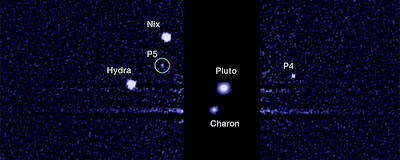Pluto’s new-found moon, visible as a speck of light in Hubble images, is estimated to be irregular in shape and between 10 and 25 kilometres across.
“The moons form a series of neatly nested orbits, a bit like Russian dolls,” said Mark Showalter of the SETI Institute in Mountain View, USA, leader of the scientific team that
The Pluto team is intrigued that such a small planet can have such a complex collection of satellites. The new discovery provides additional clues for unraveling how the Pluto system formed and evolved.
The favoured theory is that all the moons are relics of a collision between Pluto and another large Kuiper belt object billions of years ago.
Provisionally designated S/2012 (134340) 1, or P5, the latest moon was detected in nine separate sets of images taken by Hubble’s Wide Field Camera 3 on 26, 27 and 29 June, and 7 and 9 July 2012.
New Horizons, a NASA space probe, is currently en route to Pluto, with a high-speed flyby scheduled for 2015.
It will return the first ever detailed images of the Pluto system, which is so small and distant that even Hubble can barely see the largest features on its surface.
In the years following the New Horizons Pluto flyby, astronomers plan to use the infrared vision of Hubble’s planned successor, the NASA/ESA/CSA James Webb Space Telescope, for follow-up observations.
The James Webb Space Telescope will be able to study the surface chemistry of Pluto, its moons, and many other bodies that lie in the distant Kuiper Belt along with Pluto







No comments:
Post a Comment